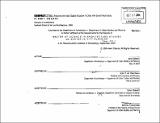| dc.contributor.advisor | Jean P. de Monchaux. | en_US |
| dc.contributor.author | Oberoi, Amit | en_US |
| dc.contributor.other | Massachusetts Institute of Technology. Dept. of Urban Studies and Planning. | en_US |
| dc.date.accessioned | 2006-02-02T18:57:47Z | |
| dc.date.available | 2006-02-02T18:57:47Z | |
| dc.date.copyright | 2004 | en_US |
| dc.date.issued | 2005 | en_US |
| dc.identifier.uri | http://hdl.handle.net/1721.1/31196 | |
| dc.description | Thesis (S.M.)--Massachusetts Institute of Technology, Dept. of Architecture; and, (M.C.P.)--Massachusetts Institute of Technology, Dept. of Urban Studies and Planning, June 2005. | en_US |
| dc.description | Leaf no. 104 repeated twice. Leaf 113 [i.e. 114] blank. | en_US |
| dc.description | Includes bibliographical references (leaves 97-104). | en_US |
| dc.description.abstract | A compact city form is one that espouses high intensity development within a restrictive geographic area. Its perceived benefits include (a) saving agricultural land (b) inducing shorter commute trips, thus less consumption of fuel and lower emission of harmful gases (c) bringing about a better quality of life through greater social interaction and (d) causing economic benefits through economies of agglomeration. In this thesis I analyze these claims based on literature review, economic models, statistical tools, and by generating hypothetical transport scenarios. Based on this analysis, I conclude that high-density development by itself has little significant association with the benefits claimed above. Further growth control mechanisms have negative externalities such as increasing land rents and causing an immense strain on congestible amenities. The thesis is divided into three parts. The first section is treated as an introduction to the concept of a "compact city". In the second section I analyze whether a compact city can deliver the benefits that its proponents claim. I look at issues such as, (i) the effect of density on urban travel behavior factors like commute distances and public transit usage; (ii) the economics at the urban edge; (iii) the claim that sprawl is inevitable, (iv) effect of growth restrictions on land rent and (v) the relevance of compaction in developing countries (most of which are already highly dense). The third section analyzes the growth management regulations and policies being implemented in Delhi. I use the conclusions drawn from the second part to comment on the appropriateness of these policies, and suggest ways in which the city could better enforce these regulations. | en_US |
| dc.description.abstract | (cont.) I chose Delhi as the case study, in part due to my familiarity with the city, but also because it offers a unique urban laboratory. Delhi's urban form could be described as the antithesis of the compact city form. Unlike most other cities, Delhi displays a positive (upward sloping) density gradient. The city is characterized by low- density development in the center and high-rise high-density at the periphery. The city owes this as much to its past as it does to its present political circumstances and planning policies. The city faces massive strains on its infrastructure due to the high in-migration rates. To accommodate the growing population, the city in the past five decades has quadrupled in area. I evaluate the urban growth management tools such as taxation policy land use policy, development of satellite towns and physical restrictions, used by the city to deal with its problem. | en_US |
| dc.description.statementofresponsibility | by Amit Oberoi. | en_US |
| dc.format.extent | 113 [i.e. 114] leaves | en_US |
| dc.format.extent | 6491409 bytes | |
| dc.format.extent | 6505419 bytes | |
| dc.format.mimetype | application/pdf | |
| dc.format.mimetype | application/pdf | |
| dc.language.iso | eng | en_US |
| dc.publisher | Massachusetts Institute of Technology | en_US |
| dc.rights | M.I.T. theses are protected by copyright. They may be viewed from this source for any purpose, but reproduction or distribution in any format is prohibited without written permission. See provided URL for inquiries about permission. | en_US |
| dc.rights.uri | http://dspace.mit.edu/handle/1721.1/7582 | |
| dc.subject | Architecture. | en_US |
| dc.subject | Urban Studies and Planning. | en_US |
| dc.title | CompactCities : analyzing the urban spatial structure in cities with growth restrictions | en_US |
| dc.title.alternative | Compact Cities : analyzing the urban spatial structure in cities with growth restrictions | en_US |
| dc.type | Thesis | en_US |
| dc.description.degree | M.C.P. | en_US |
| dc.description.degree | S.M. | en_US |
| dc.contributor.department | Massachusetts Institute of Technology. Department of Architecture | |
| dc.contributor.department | Massachusetts Institute of Technology. Department of Urban Studies and Planning | |
| dc.identifier.oclc | 61280496 | en_US |
